What Builds a Nation

Wulingyuan
What Builds a Nation – Ethan Petrou (2018, DPhil Earth Sciences)
It has long fascinated me how civilizations are influenced by the raw materials available to them. In Greece, Pentalic marble from Mount Pentelicus, renowned for its high quality due to colour and mineral inclusion, was used to construct much of the Athenian Acropolis. Headington stone and Taynton stone, limestone from Oxfordshire, gave rise to some of Oxford’s more iconic buildings, such as the RadCam. Hence, to what extent do local resources and materials, whether geological or biological, shape artistic and religious culture, guide architectural styles, and drive a nation’s geopolitical power?
In October 2023, thanks to the generosity of University College Oxford and the David and Lois Sykes Scholarship, I had the opportunity to travel around China and explore what built this great nation. China is a country with a cultural and historical identity as rich (some would argue richer) as the UK. As one of the oldest of the major world civilizations, dating back to the Xia dynasty circa 2200 BC, I was excited to explore how readily available basic materials guided the nation’s development. China’s history is profuse in science, art, politics, and philosophy, unique in that it developed somewhat isolated on the edge of the Eurasian supercontinent.
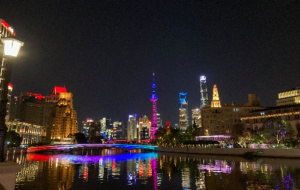
Shanghai Bund
Therefore, I ventured from big cities like Shanghai and Chengdu to small towns like Zhangjiajie and the Wulingyuan Scenic Area. I moved through history from Xi’an, China’s ancient capital established in 221 BC, during the Qin, Western Han, and Tang dynasties, to Beijing, the capital for much of the past 1000 years since the Ming and Qing dynasties. During my sojourn, I encountered a myriad of materials and minerals, each used for specific purposes or to denote particular attributes. I found it fascinating to link these with historical contexts and observe how distinct dynasties utilized and coveted different materials.
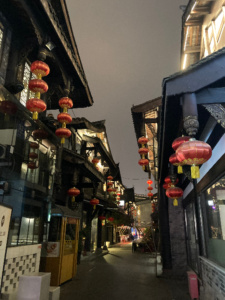
Chengdu
Sandstone
What truly makes a nation unique is its geology. It provides the stage upon which the actors make their moves. With a complex geodynamic evolution and one of the largest countries in the world, China boasts many distinct geomorphological areas that would keep any geologist busy for a lifetime.
From the Tibetan plateau to the deserts in the northwest and areas of karstic landscape with towering mountains, China’s geology kept early settlements isolated from each other and continued to make governing a unified China difficult. However, certain geology, especially in the Northeast plain, provided the fertile soil necessary for crop growth, enabling the population to flourish. One of the major rocks that influenced the landscape and was first used by civilizations in China is sandstone. Due to its strength, sandstone was one of the first rocks in China used for sculpting, such as the Leshan Giant Buddha outside Chengdu. It also produced the beautiful “avatar”-inspiring landscape in the Wulingyuan Scenic Area, where surface and underground water eroded and cut down along the vertical joints in the sandstone. Subsequent crustal uplift and gravitational collapse separated the rock masses into a forest of sandstone pillars. I was in awe during my hikes through and up these misty pillars shrouded in cloud, some as tall as 300m.
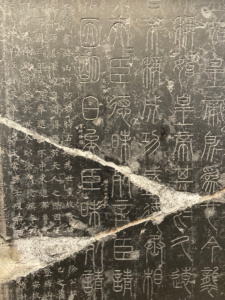
Limestone Stele
Limestone
Another classic craftable rock is limestone. This versatile rock, found in various regions of the country, has been employed by different dynasties for a multitude of purposes, whether as an artistic landscape, such as Yangshuo County, or as a canvas for intricate carvings. Steles, large, monumental slabs of limestone, have been the major medium of stone inscription in China since the Tang dynasty.
When I visited the Stele Forest Museum in Xi’an, I saw steles and epigraphs from different dynasties displaying a variety of messages, from philosophy and calligraphy forms to sacred texts. One stele I enjoyed was from the Tang dynasty, with an inscription of a letter from a general that criticized his chancellor’s wrongful seating arrangement at an official banquet.
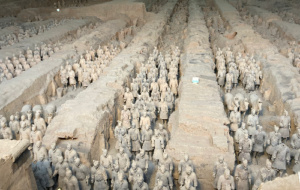
Terracotta Warriors
Clay
By far my favourite material for its versatility, the use of clay paved the way to modern China. Firing clay into bricks produced iconic structures such as the Great Wall near Beijing and the Xi’an City Wall, both used for fortification, dating back to 220 BC and the 14th century, respectively.

Great Wall
It was astounding to be on the Great Wall, atop and surrounded by mountains, marvelling at how challenging it must have been to construct this fortification. The walls at Xi’an mark the end of the Silk Road and the ancient capital. In Xi’an, clay also created the Terracotta Warriors, a 2200-year-old army of stoic, life-size figures used as funeral art in Emperor Qinshihuang’s mausoleum. I was struck by the magnitude of these pieces, as every single foot soldier, archer, cavalryman, horse, and general is unique, and the excavation is ongoing. I also learned that they were originally intricately painted. Clay has also been widely used in art, and the beautiful Blue and White Porcelain Pots, predating Dutch Delft Blue, show changes in style and complexity since the Tang dynasty. My final note on clay is the intricate roof motifs that were produced. In old towns, your roof motif pattern and style would denote your profession and rank. In temples, several animal figures adorned the corners of the roof, always an odd number, and the more animals, the more recognized the site. The most I saw was ten, the only exception, at the Hall of Supreme Harmony in Beijing.

Panda Conservation Park
Bamboo
China has the most abundant and diverse bamboo species globally and has long been a cultural icon in Chinese history. Bamboo played a pivotal role in ancient China, influencing daily life through food, clothing, and shelter. Their first books were handcrafted from bamboo strips, and the musical landscape was dominated by bamboo instruments. Furthermore, bamboo had significance in feudal ethics and has been used to create sculptures since the Neolithic period. The National Museum of China in Beijing showcased many of these works, and I greatly enjoyed those from the Ming dynasty. Bamboo is also the major food source for the giant panda, and I spent many hours walking through the bamboo forests at the Chengdu Research Base of Giant Panda Breeding, watching the pandas break, eat, and play with bamboo. The young pandas were adorable.
Wood
One of the four great inventions of Ancient China was papermaking, and bark from the mulberry tree, prevalent in China, was one of the main materials used for it. It revolutionized communication in the Han dynasty and became a symbol of advanced science. Additionally, resin extracted from trees and delicately applied to wood produced the beautiful carved lacquer wares used for decoration. China was the earliest country to use lacquer, and I saw a myriad of elegant pieces in the Sichuan Museum from the Han and Tang dynasties. Wood was also prized by the later Ming and Qing dynasties, with large sections of the Forbidden City, Summer Palace, and Temple of Heaven in Beijing made of wood from jungles in southwestern China. The architecture was so different from Europe that it felt otherworldly to walk around these sites. I particularly liked that the Temple of Heaven, a 38m tall structure, was all held up by wood, all slotted together in intricate designs that required no nails.
Malachite and Azurite
Malachite and azurite, both copper carbonate minerals, crystallize in intense green and blue colours, respectively. Due to their wide availability, these minerals have been used in Ancient China since the Eastern Zhou period, primarily for ornamental sculptures but most commonly in artwork. When prepared correctly, these minerals produce vivid, long-lasting pigments that have been used in traditional painting and ink for letter writing. I had the opportunity to admire some beautiful pieces of artwork that used these minerals for colour in the National Museum of China, and their colours remain vibrant to this day. These minerals were also prized gemstones in pre-Han China, and I observed some jewellery featuring them in the Forbidden City. The popularity of these minerals in painting declined during the Ming and Qing dynasties, as a shift to synthetic copper pigments was adopted for large architectural projects.
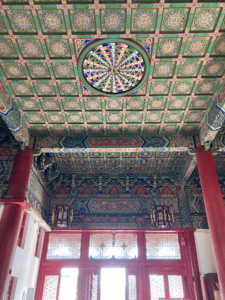
Xian Bell Tower Roof
Jade
Only two different kinds of minerals found in nature have been defined as “genuine jade”: Nephrite, a member of the tremolite-actinolite solid solution series, and jadeite, a metamorphic mineral of sodium aluminium silicate. Both can vary dramatically in colour, with jadeite being the more commonly thought-of emerald-green jade colour. In China, five to six thousand years ago, jade was undifferentiated from ordinary stones used for tools. Through experience, the enduring nature and toughness changed the mineral into one of the precious stones of the nation. Jade discs inscribed with ancestors’ names were used in worship with patterns that developed and changed from the Warring States Period to the Han dynasty. Members of high status would be buried in a funeral suit sewn of jade pieces, and during the Western Zhou dynasty, a whole set of jade-carved weaponry was added. The Qing dynasty produced jade in high quantities, with varied uses and styles, eventually influenced by Islamic jades.
In the Forbidden City in Beijing, I saw a whole host of beautifully carved jade pieces, each emphasizing the natural colour of the jade, from bracelets to sculptures. Being palace jades, they were unsurprisingly grand in size, rich in colour, and pure in texture. While in Chengdu, I visited the Wenshu Yuan Monastery and was confronted with a jade Buddha statue nearly five meters tall.
Bronze
One such material that piques my interest is bronze. The Bronze Age in China emerged around the late Xia dynasty (early 17th century BC) and persisted for about 1,500 years across various dynasties, from Shang to Western Zhou and Eastern Zhou. Bronze was mainly cast into ritual objects and weaponry and was a status symbol to possess. Notably, bronze artifacts remained in use, even with the later introduction of iron during the Qin and Han dynasties. For its durability and versatility, bronze travelled with me as I moved through China, all under the guise of worship or warfare.
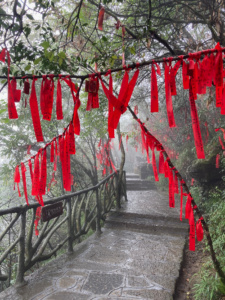
Tianmenshan
From large cauldrons filled with water in the Forbidden City or on the Great Wall for creating fire to the half-size bronze cast horses and chariots in Emperor Qinshihuang’s mausoleum, warfare bronze revolutionized weaponry and defence. Inscriptions on bronzes, either by casting or engraving, are characteristic of Chinese bronzes, making them unique from those produced in other cultures. This was more noticeable in bronzes used for worship, such as the large incense-burning troughs in temples like Tianmenshan Temple, Buddhas at sites like the Giant Wild Goose Pagoda in Xi’an, and the Summer Palace in Beijing, and bells rung for morning like the Bell Tower of Xi’an.
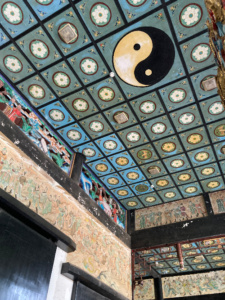
Qingyang Palace Roof
Gold
Atypical of ancient civilizations, gold in China wasn’t the hallmark of supreme excellence. Long before the development of metalwork, the art of working with jade was perfected, making it the symbol of status in the Neolithic and early dynasties. After that, bronze became a highly sought-after metal due to its availability and malleability. Because of the nation’s reverence for its history and the absence of foreign invasions well into the first millennium, cultural customs from the Neolithic period were preserved and solidified in the later dynasties. Gold eventually gained popularity but never completely replaced jade and bronze as true symbols of power, immortality, and prestige. As a result, I only observed gold pieces in the Forbidden City in Beijing, which were commissioned during the later Ming and Qing dynasties. These were notably bespoke jewellery or timepieces. Quite often, gold was used as an augmentative material for more magnificent pieces of jade or precious stone. I did observe a gilded bronze roof of a worship hall in Xi’an and some small gold Buddha figures in temples in Chengdu, indicating the importance of gold in rituals. Today, China ranks as the world’s largest gold producer, suggesting that attitudes toward this mineral could be undergoing significant changes.
In the end, we are all bound by geology. It provides the fundamental (and literal) building blocks of society and can predetermine whether a nation will thrive, what its weaknesses are, and how to predict its motives and movements in geopolitics. China has all the required raw resources to thrive and through this developed a nation with great and unique culture.
Ethan Petrou (DPhil Earth Sciences, 2018)
Feel free to contact me with comments or questions via the Univ Development Office.
Special thanks to Tony, Wilson, Jenny, Shawn, Sam, Rachel, and Flora for their kindness and showing me around. It was great meeting again!
Cities visited: Beijing, Xi’an, Chengdu, Wulingyen, Zhangjiajie, Shanghai
Top apps for future travellers: Alipay, WeChat, Apple Maps, Apple Translate, Cisco Secure Client
Book high-speed train tickets in advance: “China Highlights” train booking service
SIM Card: I bought at the airport, but you could get an e-sim from “mobimatter”.
Visa: Apply online, mine took a week to process after interview.
Find out more about the range of travel grants and scholarships available to assist Univ students on our Travel Grants page or read further travel reports.
Published: 29 July 2024
